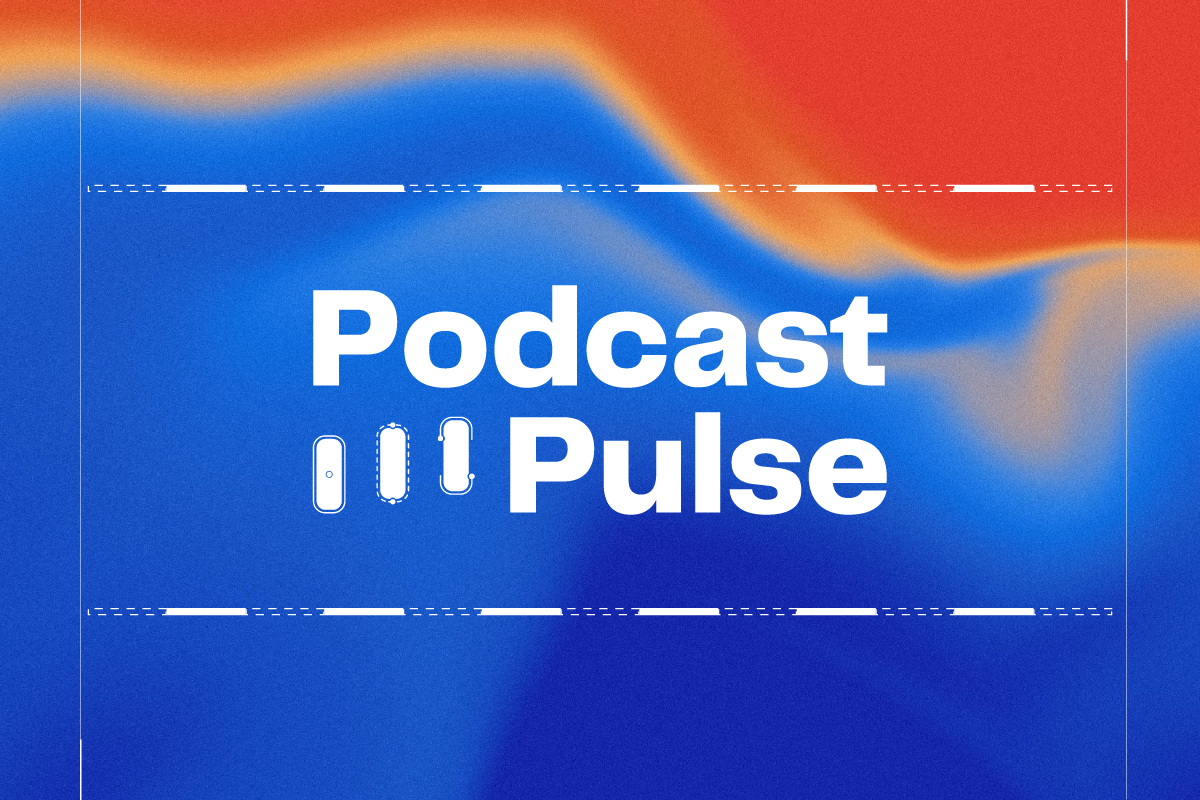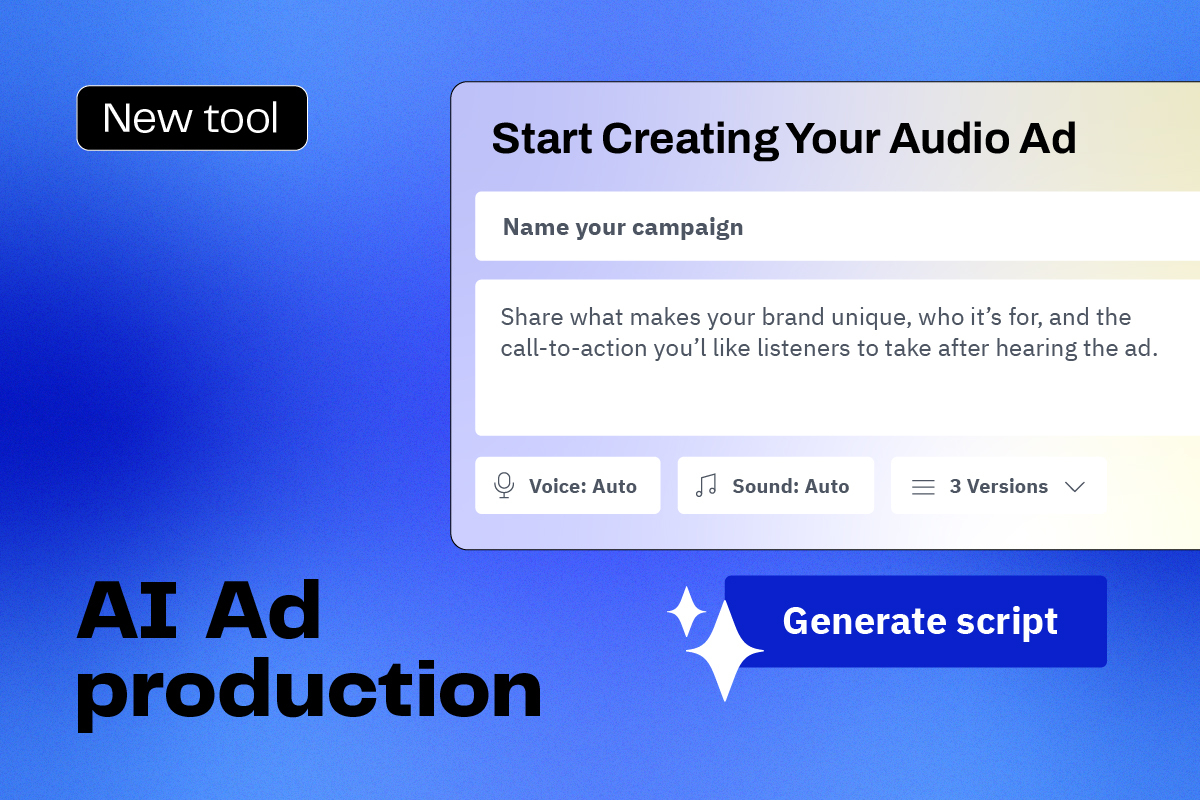When Mixed Messages Are Good: Including Ads And Sponsorships in Campaigns to Improve Performance and Reach New Podcast Listeners

There is no debating that podcasting remains a growing medium with projections of a $94.88 billion industry valuation by 2028 and ad spend in the US market alone slated to eclipse $4 billion by next year. Going beyond the dollar signs, listenership continues to grow as well with eMarketer reporting 98 million Americans are weekly podcast listeners – a nearly 7% increase from a year ago – and projecting that number to boom to 119 million weekly listeners by 2026.
However, with this rapid growth comes debates on how best to reach the medium’s engaged and emerging audiences.
Media buyers, sellers, and creators are beginning to draw their lines in the sand and form allegiances to a singular strategy. To some, the great Podcast Ad or Sponsorship Debate is becoming as polarizing as Coke versus Pepsi loyalties.
But unlike cola products, podcast advertising doesn’t have to be – and shouldn’t be – an “or “ question. In fact, according to Acast research, the most effective podcast advertising strategies leverage both ads and sponsorships. This is particularly true for moving the needle on top of the funnel metrics like brand awareness and lead generation.
Before we get into the weeds of this research and campaign performances, it’s important to decipher what exactly is a podcast ad and what is considered a sponsorship.
Podcast ads can be defined as short pre-recorded messages created by a brand (rather than the podcaster) that offer meaningful reach at scale and can be bought directly from a dedicated sales team or programmatically using bid-based buying technologies. Additionally, with Acast media buyers can also book podcast ad campaigns themselves through our self-serve podcast advertising platform.
The commonly-heard podcast sponsorship differs from an ad spot because sponsorships are longer, editorialized messages recorded by the podcasters themselves.
Both ads and sponsorships occur in the pre-roll, mid-roll, or post-roll of an episode. And, perhaps most importantly, when bought through platforms like Acast that operate in the open ecosystem, podcast ads and sponsorships travel with the content. For advertisers, this means their message can reach listeners across every listening app, including Apple Podcasts, Spotify, Amazon Music and more. This also means that advertisers can connect with premium users on popular paid platforms such as Spotify.
Using these definitions, Acast conducted 21 individual global brand lift studies in partnership with Attest to discover the impact of mixing sponsorships and ads within a campaign. The research specifically explored three key performance indicators: Brand Awareness / Familiarity, Brand Favorability, Purchase Intent / Consideration.
According to the study, while each category did experience growth with just sponsorships, those that included both ads and sponsorships resulted in a double to triple digit percentage change in lift.
Brand Awareness / Familiarity:
- Only sponsorships: increased 6 percentage points
- Sponsorship and ads included: increased 20 percentage points
- Total resulting change in lift: 233%
Brand Favorability:
- Only sponsorships: increased 20 percentage points
- Sponsorship and ads included: increased 28 percentage points
- Total resulting change in lift: 40%
Purchase Intent / Consideration:
- Only sponsorships: increased 22 percentage points
- Sponsorship and ads: increased 25 percentage points
- Total resulting change in lift: 14%

According to another study by Acast that explored the characteristics and habits of new US podcast listeners, these listeners are 6% more likely than average listeners to listen to ads and 70% more likely to make purchases because of podcast ads than average podcast listeners.
This behavior shift in new podcast listeners preferring ads over sponsorships creates opportunities for better measurement and attribution across campaigns. More specifically, Acast works with third party vendors including Podsights, ArtsAI, Claritas, Veritonic, and others to enable pixel based attribution solutions.
These vendors use pixels, or small pieces of JavaScript that are also included on the brand site, to collect insights like IP addresses and user agents the moment an ad is served to a listener. The vendor then uses a device graph to match the IP address in real time, effectively enabling attribution at the household level for podcasting. This is significant because podcasting has historically provided very limited data to advertisers on campaign performance, forcing them to rely on tools and strategies that require the listener telling them they heard a campaign like discount codes, custom URLs, and surveys. With pixel based attribution advertisers can now effectively track and measure their podcast ad campaign at every step of the conversion funnel.
Not only do these new audiences and their behaviors enable advertisers to track and measure their campaigns, but they also create more opportunities for brands to form contextually-relevant connections. In fact, these new audiences reported to be 17% more likely to want to be advertised to in a contextually-relevant way. For advertisers, this means leveraging ad innovations like Acast’s suite of Conversational Targeting tools that enable accurate targeting of specific keywords and phrases spoken within a podcast episode will be crucial in connecting with these new audiences in an authentic way.
The research also shows these audiences are dialed into the medium and reported to be 75% more likely than average listeners to increase their podcast consumption in the next six months.
As podcasting continues to mature as a medium by inviting new audiences to the space, ads will play an increasingly relevant role in brand strategies. Today’s media buyers will benefit by recognizing and adapting to this changing lndscape by diversifying their approach with both sponsorship and ad content in order to reach the most listeners in the most effective way.
For more information about how to incorporate both ads and sponsorships into your podcast advertising strategy, please reach out to sales@acast.com.
There is no debating that podcasting remains a growing medium with projections of a $94.88 billion industry valuation by 2028 and ad spend in the US market alone slated to eclipse $4 billion by next year. Going beyond the dollar signs, listenership continues to grow as well with eMarketer reporting 98 million Americans are weekly podcast listeners – a nearly 7% increase from a year ago – and projecting that number to boom to 119 million weekly listeners by 2026.
However, with this rapid growth comes debates on how best to reach the medium’s engaged and emerging audiences.
Media buyers, sellers, and creators are beginning to draw their lines in the sand and form allegiances to a singular strategy. To some, the great Podcast Ad or Sponsorship Debate is becoming as polarizing as Coke versus Pepsi loyalties.
But unlike cola products, podcast advertising doesn’t have to be – and shouldn’t be – an “or “ question. In fact, according to Acast research, the most effective podcast advertising strategies leverage both ads and sponsorships. This is particularly true for moving the needle on top of the funnel metrics like brand awareness and lead generation.
Before we get into the weeds of this research and campaign performances, it’s important to decipher what exactly is a podcast ad and what is considered a sponsorship.
Podcast ads can be defined as short pre-recorded messages created by a brand (rather than the podcaster) that offer meaningful reach at scale and can be bought directly from a dedicated sales team or programmatically using bid-based buying technologies. Additionally, with Acast media buyers can also book podcast ad campaigns themselves through our self-serve podcast advertising platform.
The commonly-heard podcast sponsorship differs from an ad spot because sponsorships are longer, editorialized messages recorded by the podcasters themselves.
Both ads and sponsorships occur in the pre-roll, mid-roll, or post-roll of an episode. And, perhaps most importantly, when bought through platforms like Acast that operate in the open ecosystem, podcast ads and sponsorships travel with the content. For advertisers, this means their message can reach listeners across every listening app, including Apple Podcasts, Spotify, Amazon Music and more. This also means that advertisers can connect with premium users on popular paid platforms such as Spotify.
Using these definitions, Acast conducted 21 individual global brand lift studies in partnership with Attest to discover the impact of mixing sponsorships and ads within a campaign. The research specifically explored three key performance indicators: Brand Awareness / Familiarity, Brand Favorability, Purchase Intent / Consideration.
According to the study, while each category did experience growth with just sponsorships, those that included both ads and sponsorships resulted in a double to triple digit percentage change in lift.
Brand Awareness / Familiarity:
- Only sponsorships: increased 6 percentage points
- Sponsorship and ads included: increased 20 percentage points
- Total resulting change in lift: 233%
Brand Favorability:
- Only sponsorships: increased 20 percentage points
- Sponsorship and ads included: increased 28 percentage points
- Total resulting change in lift: 40%
Purchase Intent / Consideration:
- Only sponsorships: increased 22 percentage points
- Sponsorship and ads: increased 25 percentage points
- Total resulting change in lift: 14%

According to another study by Acast that explored the characteristics and habits of new US podcast listeners, these listeners are 6% more likely than average listeners to listen to ads and 70% more likely to make purchases because of podcast ads than average podcast listeners.
This behavior shift in new podcast listeners preferring ads over sponsorships creates opportunities for better measurement and attribution across campaigns. More specifically, Acast works with third party vendors including Podsights, ArtsAI, Claritas, Veritonic, and others to enable pixel based attribution solutions.
These vendors use pixels, or small pieces of JavaScript that are also included on the brand site, to collect insights like IP addresses and user agents the moment an ad is served to a listener. The vendor then uses a device graph to match the IP address in real time, effectively enabling attribution at the household level for podcasting. This is significant because podcasting has historically provided very limited data to advertisers on campaign performance, forcing them to rely on tools and strategies that require the listener telling them they heard a campaign like discount codes, custom URLs, and surveys. With pixel based attribution advertisers can now effectively track and measure their podcast ad campaign at every step of the conversion funnel.
Not only do these new audiences and their behaviors enable advertisers to track and measure their campaigns, but they also create more opportunities for brands to form contextually-relevant connections. In fact, these new audiences reported to be 17% more likely to want to be advertised to in a contextually-relevant way. For advertisers, this means leveraging ad innovations like Acast’s suite of Conversational Targeting tools that enable accurate targeting of specific keywords and phrases spoken within a podcast episode will be crucial in connecting with these new audiences in an authentic way.
The research also shows these audiences are dialed into the medium and reported to be 75% more likely than average listeners to increase their podcast consumption in the next six months.
As podcasting continues to mature as a medium by inviting new audiences to the space, ads will play an increasingly relevant role in brand strategies. Today’s media buyers will benefit by recognizing and adapting to this changing lndscape by diversifying their approach with both sponsorship and ad content in order to reach the most listeners in the most effective way.
For more information about how to incorporate both ads and sponsorships into your podcast advertising strategy, please reach out to sales@acast.com.





